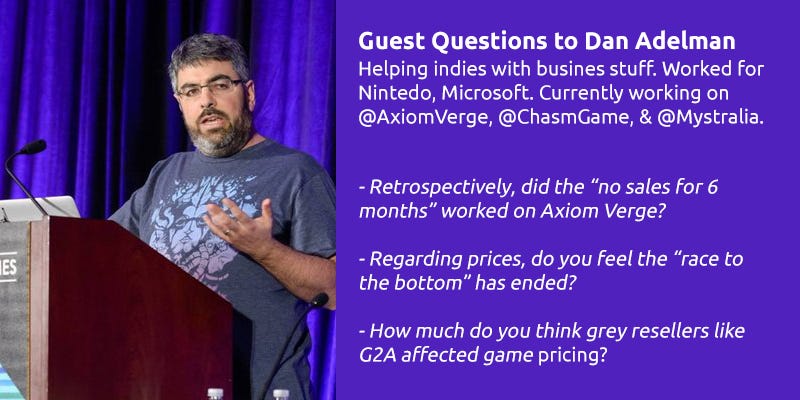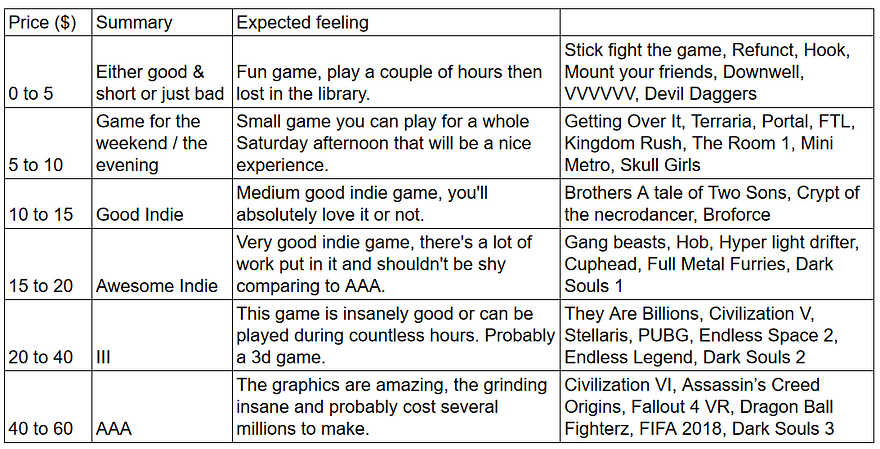Trending
Opinion: How will Project 2025 impact game developers?
The Heritage Foundation's manifesto for the possible next administration could do great harm to many, including large portions of the game development community.

Featured Blog | This community-written post highlights the best of what the game industry has to offer. Read more like it on the Game Developer Blogs or learn how to Submit Your Own Blog Post
Putting a price on a years work is super hard! Let's explore some basic pricing stuff you should consider and think about.

Everyone has an opinion about the price of video games. Gamers often think games are too expensive. Game developers think it’s not expensive enough, except for their own game. Pricing is hard because it mostly sets things in stone. Once your game releases, there will be very few occasions to change its price, and every time you do it, it will have an impact. Let’s look at some psychological barriers.
There are more and more games every year. Competition wasn’t a problem before, because there were very few games so every release was properly covered by the press and could guarantee you a specific amount of sales. Competition will become a growing problem for game developers.
You can’t set a price to a game and expect that nobody will look at other games of the same genre and their pricing. For people that are living on a budget, it’s a good factor to choose which game to buy.

gif by Thalia De Jong
F2P, for instance, are hardcore competitors for this. With the amount of great F2P games out there, it’s easy for a gamer to play games and never pay anything for it. I’ve been working on Battlerite, a multiplayer arena game in a $20 Early Access.
On the long term, it’s been hard to compete with some games such as League of Legends or Heroes of the Storm. With multiplayer, you have to play with your games. If your friends want to try the game, they have to pay it $20 and refund it later. Or they could just launch a F2P and not really care.
In the end, ask yourself those questions:
What are the prices of games similar to mine?
Should I be cheaper or more expensive than them? Why?
What is my unique selling point that my F2P competitor can’t match?
Some game developers like to make their game more expensive at release, to anticipate for time-limited sales or bundles.
Sales are a must-do in our industry. At least that what you could think. Other game developers decided to use the Fuck Sales Method.
Axiom Verge’s creators said on launch that there’ll be no sales for at least 6 months after release. It’s a way for them to say players that if they’re waiting for sales, they’ll wait a long time. There is no real way to say if it’s a good attitude, at least for this game, it brought them a lot of money. The game has a very good long tail, and the no sales mean that they have a very good rate between copies and revenue.
There are very good articles around about pricing games, so you should read this one at least by Dan Adelman.

Tavrox: Retrospectively, did the “no sales for 6 months” worked on Axiom Verge?
Dan: I actually conducted a very non-scientific survey about this on our Steam forums. The short answer is that I don’t think the announcement actually changed many people’s behavior. Many people hadn’t heard the announcement, and among those that had heard about it, they either heard about it after buying the game or were planning on paying full price anyway. That said, the act of just not putting the game on sale for 6 months did have a positive effect on maintaining the game’s value. We launched in April or May, and some people were disappointed that we didn’t participate in the Steam summer sale. We finally put the game on sale for the first time over the holidays, so that initial modest price drop was in and of itself noteworthy. I still really like the idea of setting expectations for discounts. I think one reason that the announcement didn’t change people’s behavior much is that it’s not a standard part of the game release process. Normally developers talk about their release date, price, and platforms. If all developers made it a habit to include in their initial announcement some detail about how soon the first sale might be, consumers will know to look for that information.
T.: Regarding prices, do you feel the “race to the bottom” has ended?
D.: I’ve been encouraged to see lots of indie developers charging sustainable prices and resisting the urge to keep discounting. I think one reason for this might be because of the way Steam is conducting its holiday sales now. In the past, games would be on sale throughout the holiday period but on one day any individual game would have an even steeper discount. Valve highlighted those special deals and consumers would share information about the deals of the day. There were entire blog posts and discussion threads about the optimal strategy of when to buy what during a Steam sale. Steam’s new price protection policy doesn’t work with the one-day only special sale approach, so holiday sales have one price for the entire duration. The result is that there is less urgency to grab a hot deal while it’s active. Although that makes events like the holiday sales a little less impacting, I think it’s a healthier way for the industry to go. Thanks to the price protection policy, consumers don’t need to worry that they’ll regret buying a game because it became 50% cheaper the next day. If consumers are confident they’re not going to be made to feel like a sucker, they may not mind paying full price. I’d love to see if Valve has any data on this!
T.: How much do you think grey resellers like G2A affected game pricing?
D.: I suspect that G2A and other bottom feeders really tend to impact those people who have let a bunch of keys get out into the wild, particularly through name your own price bundles. There are too many people out there able to buy up keys for pennies and dump them on sites like G2A. Since Axiom Verge has never been in a bundle like that, very few people offer up Axiom Verge keys there. In fact, I just checked, and there is only one available for sale, and it’s listed for $17.11 — only about 10% lower than the regular price. Companies like Tiny Build have done a great job in spreading awareness of damaging these sites are, and I believe a lot of people who might have bought from them before are choosing to stay away. Again, I don’t have any data on this, but I think continuing to drive awareness is huge. In the long run if developers can’t get paid for their work, the amount of quality content will dry up. It’s a fragile ecosystem, and it’s in all of our best interests to protect it.
The length of a game has always been a big criterion to buy a game. Some games are free and can be played for several thousands of hours (I played 3000 hours of League of Legends). Some games are very expensive but very intense and provide unique experiences. How should you, and the players, look at the replayability criterion?
First, be empathetic with your user. Some have little money and have the right to be pissed if your game is way too short but still enjoyed it. It’s also OK to tell them to fuck off.
Two, take this criterion into account from the ground up. It’s highly linked to other games. While doing your market research, it’s important to write down the average game length of your competitors. It will help you choose: match with them, do better, or be completely different?
The replayability issue is important with multiplayer games. Those games are only mostly good when you play it with your friends. When your friends stop playing this game because they get bored, you’ll probably stop too. That’s why building communities as game developers is SUPER important. You don’t want your players to feel lonely and quit the game!
When mobile games emerged with iPhone, they started the pricing between $1 to $3, because they didn’t really know what to do with it. It’s just a game on the phone, right? This threshold lasted a long time, and people often said “This game costs as much as a coffee”.
We kind of have the same thing on PC and Console gaming. Console games used to cost $60, Handheld games cost $30 and PC Games cost between those two ranges. When the indie wave started on XBLA, we started to see games that were priced around $10 to $20
It’s easy for an industry without regulations to go down the path of underpricing. “If you’re cheaper than the competition, you’ll be able to borrow sales from them”. But we’re now forgetting that video games are only leisure so the price is not the primary factor.
Here is a sample list of threshold built from my point of view, for Steam games. It’s not set in stone but can help you position your game’s pricing. I’ve voluntarily added examples that totally contradict the expected feeling.

Writing this table helped me notice a trend. On licenses such as Dark Souls and Civilization, you can easily spot the threshold!
Dark Souls 1 : $20
Dark Souls 2 : $40
Dark Souls 3 : $60
Civilization III : €5
Civilization IV : €20
Civilization V : €30
Civilization VI : €60
Study the market, take a look at the prices of games that might compete with yours, and build up your strategy regarding theirs and the potential long tail of your game. :)
Read more about:
Featured BlogsYou May Also Like